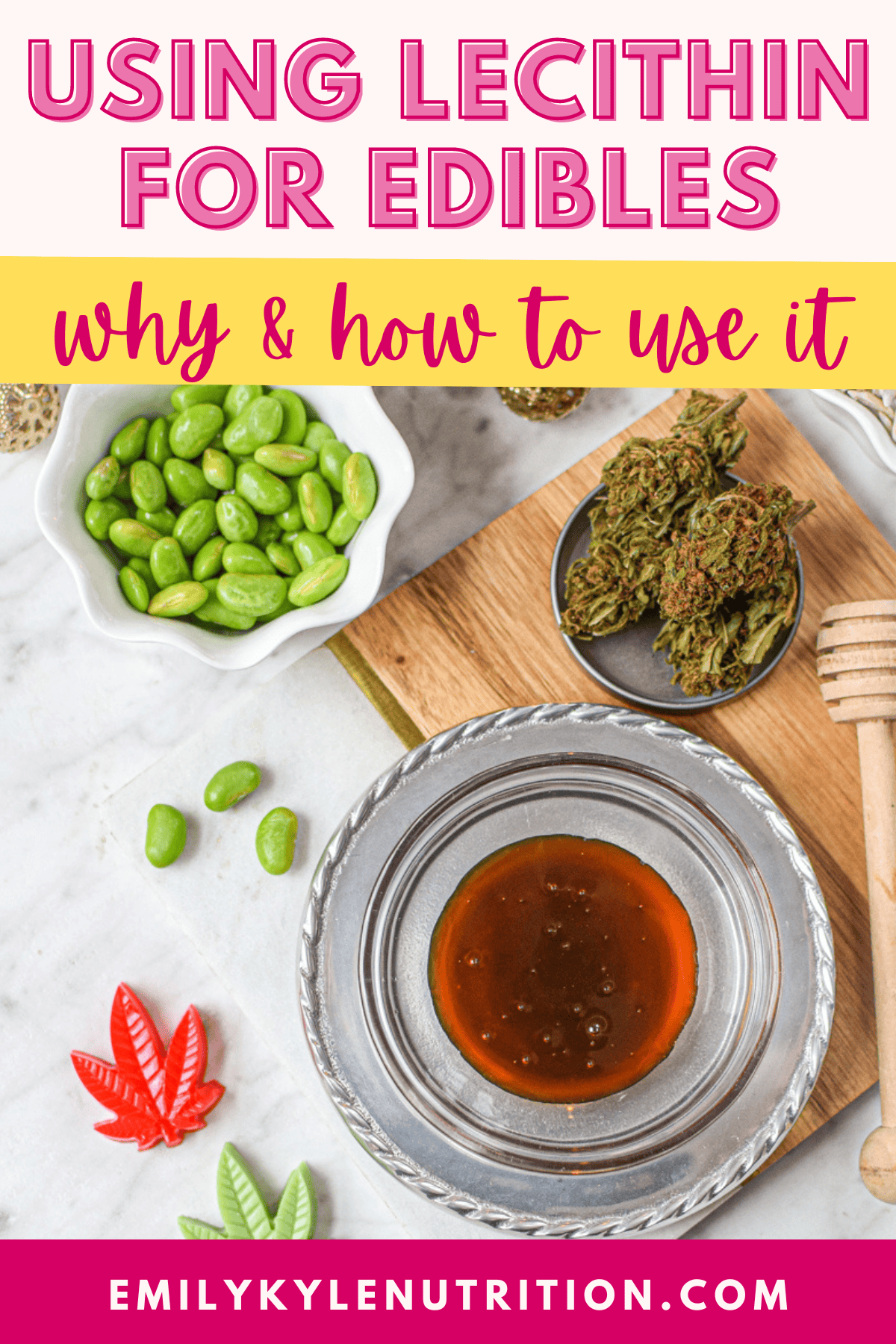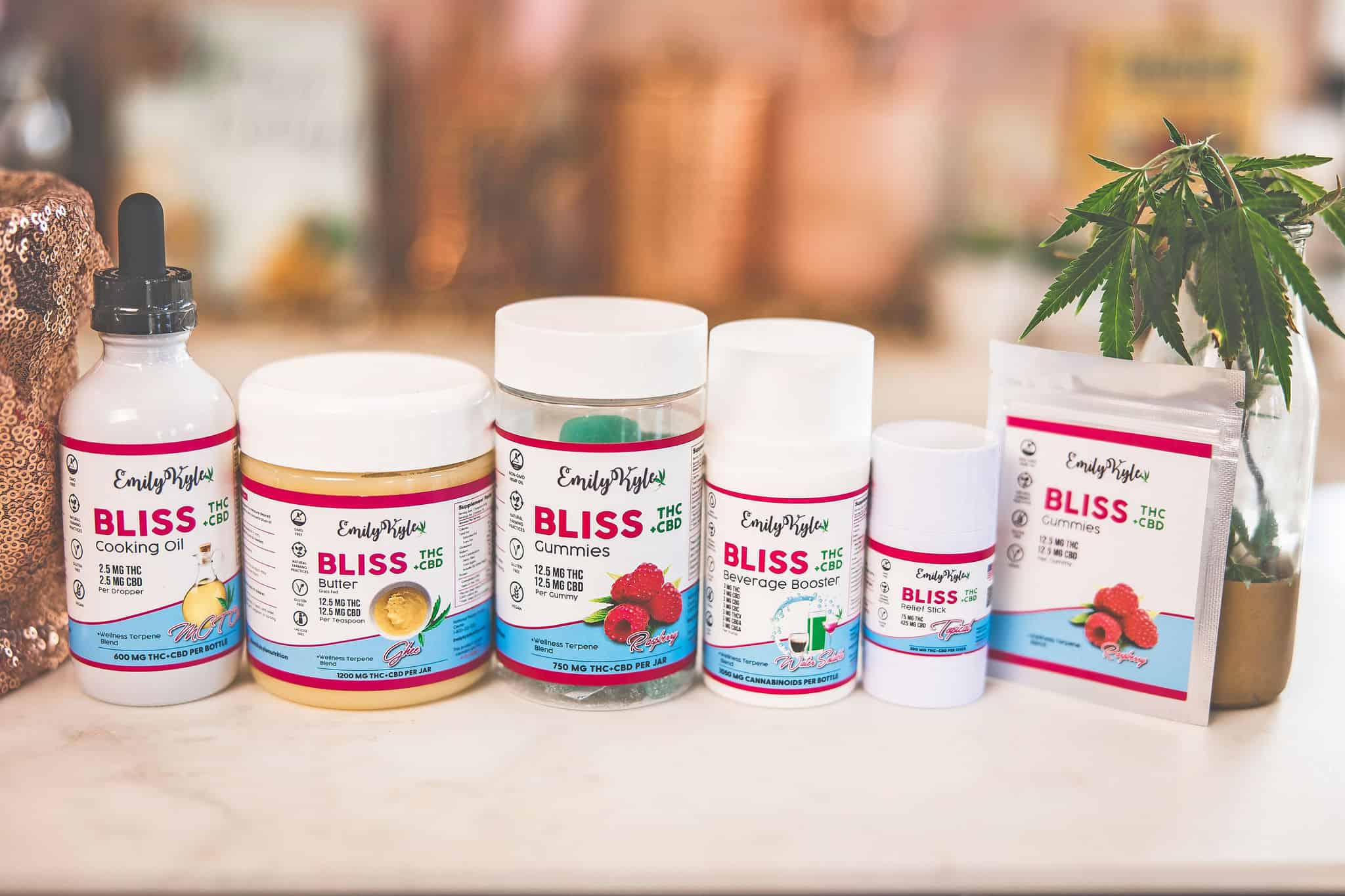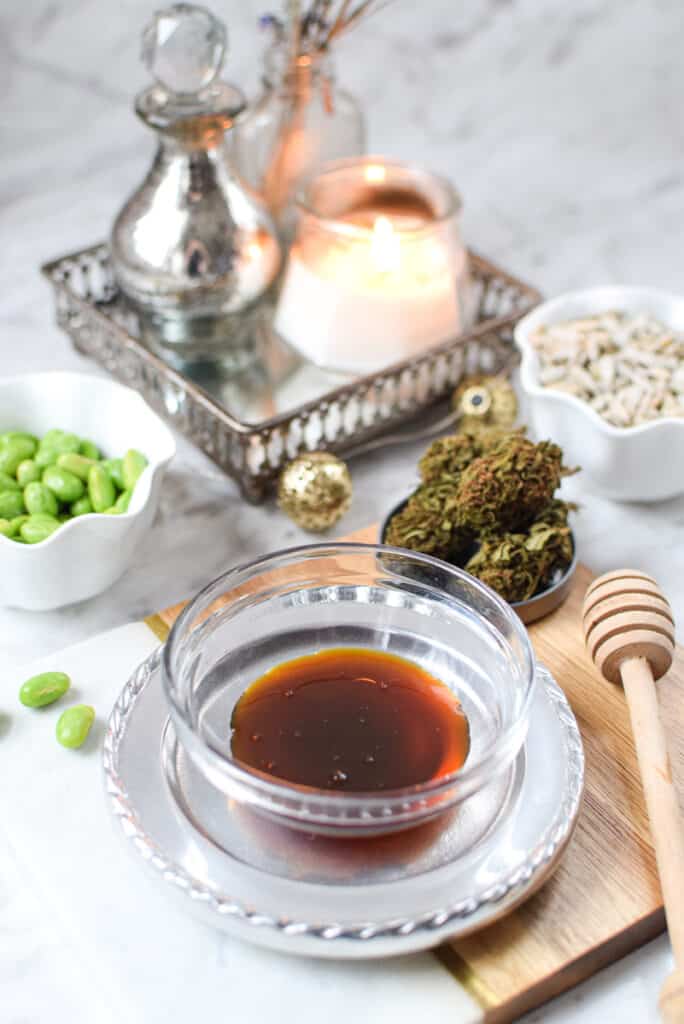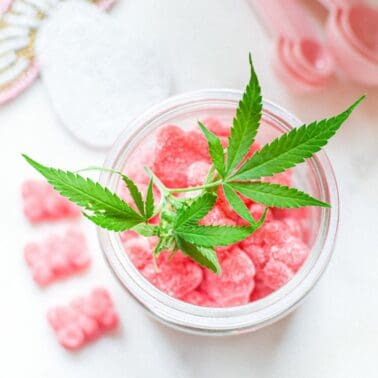Are you ready to make your own infused oil or edibles but feel hung up on whether or not you need to add lecithin? Discover the two main reasons you may want to use lecithin in your cannabis cooking and learn when you should – and shouldn’t – use lecithin when making your own edibles at home.

Table of Contents
Article Features
- Two good reasons to use lecithin in recipes
- Recommendations for where to buy lecithin
- Want to skip the hard work? Shop with me and have premium, high-quality cannabis products delivered directly to your door! Now shipping across the US.

Lecithin For Cannabis Edibles
I recently received this question from Mollie, a member of my Well With Cannabis Community:
“Lecithin in gummies…..is it necessary? Also, if I have it in powdered form, is there a way to mix it with water so I could use it in the recipe?”
A great question!
Here, we will take an in-depth look at lecithin, lecithin benefits, and when, and why you want to use it in your cannabis edibles.
We will also explore the different forms like powdered or liquid, sunflower or soy, and where to buy each kind.
What is Lecithin?
Lecithin is a type of fat essential for properly functioning cells in our body.
This natural phospholipid substance can be derived from soybeans, sunflowers, eggs, avocados, and more.
Lecithin can be found naturally within these foods or as a supplement purchased online or at a health food store.
Lecithin may be a new ingredient you’re not used to cooking with, but it can be an important staple ingredient for any cannabis kitchen.
Next, we will dive deep into why people use lecithin when making cannabis edibles and explore if adding lecithin is right for you and your needs.

Why Use Lecithin in Edibles?
If you’re brand new to edibles, you may be unfamiliar with lecithin and why people use it in their at-home infusions and baked goods.
There are two primary reasons people use lecithin in edibles:
- To act as a stabilizer and emulsifier to combine oil and water for recipes like cannabis gummies
- To increase the potency of an infusion by increasing the bioavailability of cannabinoids in the body
Basic culinary science is the first reason for adding lecithin to edibles as an emulsifier.
Like water and oil, two opposing ingredients will never naturally combine without adding an emulsifier.
They will naturally separate over time, leaving a layer of water and a layer of oil.
Adding an emulsifier, like an ingredient containing lecithin, can help bond the two opposing ingredients together, preventing separation naturally.
Lecithin has the ability to combine oil in water AND water in oil, making it ideal for all infusions.
The second reason for adding lecithin to edibles is a theory that believes lecithin can increase the potency of an infusion by increasing the bioavailability of cannabinoids in the body.
It is believed that this increased bioavailability, defined as the “ability of a substance to be absorbed and used by the body,” will produce a more potent effect.
We will explore these reasons below so you know if using lecithin in your edibles is the right choice for you.
Reason #1
Emulsification, or to emulsify, is a process used in culinary science, in restaurants, by Chefs, and even at-home cooks.
By definition, “when you emulsify something, you mix it so thoroughly that it becomes an emulsion.”
In other words, it will no longer separate over time.
For example, in your home kitchen:
Keeping opposing ingredients together in certain recipes, like oil and vinegar in a salad dressing, is hard.
When you vigorously shake the dressing, the two ingredients combine, but when left to sit for some time, they separate back out again.
This is because there is nothing to hold the two ingredients together or emulsify them.
If you were to add another ingredient to your dressing that naturally contained lecithin, such as egg yolks, the dressing would remain emulsified and not separate.
When you make cannabis edibles at home, you will want to use lecithin as an emulsifier when making certain recipes.
The most common recipes that call for lecithin include:
- Cannabis gummies made with oil
- Cannabis lemon vinaigrette
- Hot drinks made with added cannabis oil, such as coffee, tea, and lattes
How Much Lecithin to Add
Most recipes that require lecithin will tell you the amount that is needed.
For example, this gummy recipe specifically calls for two teaspoons of lecithin for the entire recipe.
However, if the recipe does not call for a specific amount, adding one teaspoon of lecithin per 1 cup of liquid is a good rule.
You don’t need to add much to get the emulsification you need.
However, if separation continues, you can add more lecithin as needed.

Warning: When NOT to Use Lecithin
There are a few members of my Well With Cannabis Community who have reported a common issue:
Accidentally adding lecithin to a cannabutter infusion made with water is a big disaster.
While I prefer the crockpot method for making cannabutter, you can also use the stovetop method or an infusion machine.
When cooking cannabutter on a stovetop, the temperature can fluctuate quite a bit, so folks add water to the pot.
The water helps regulate the butter’s temperature, preventing it from getting too hot and burning the butter, potentially denaturing the cannabinoids.
However, the water is removed and discarded at the end.
If you add water to your cannabutter infusion, do NOT add lecithin.
This will bind the water and butter together, resulting in a soupy mess and an undesirable end product.
If you’re using the stovetop method to make cannabutter or CBD butter, wait until all the water has been separated from the final product before stirring in the lecithin at the end.
Reason #2
Many cannabis cooks swear by adding lecithin to their oil-based infusions to make them stronger and more potent.
With this theory, it is believed that using lecithin will make valuable cannabinoids like CBD and THC more bioavailable or ready for use by the body, ultimately making the edible experience stronger.
While there is little scientific evidence to support this claim, there is ample anecdotal evidence of people who claim that adding lecithin makes all the difference in their overall experience.
Lecithin is a health food supplement, so it won’t hurt to experiment with it and see if it is right for you.
When experimenting with lecithin in oil infusions, adding it before heating or infusing it is common.
Again, a common recommendation is to add one teaspoon of lecithin per 1 cup of oil or butter.
Lecithin can be added to the following infusions:
- Coconut oil
- Olive oil
- Butter or ghee *not butter infusions that have water; see disclaimer above.
If you have already made your infusion, you can still add lecithin.
Gently heat up your infusion and add the lecithin, stirring until dissolved and well incorporated.
Different Forms of Lecithin
Many different forms of lecithin available on the market today can be found online or in health food stores.
The most common forms are soy or sunflower lecithin, found in powder, granulated, or liquid forms.
Generally, they all function pretty much the same and can be used interchangeably in recipes unless a specific form is otherwise called for.
Powdered or Granulated Lecithin
Lecithin powder, or granules, is a dry, processed version of lecithin that has been extracted from other ingredients, such as eggs or soy.
Most powdered or granulated lecithin is created as a by-product of making oil.
Lecithin granules or powders are typically less than 10% fat and have more hydrophilic properties, so they can easily dissolve in water.
The main benefit of powdered or granulated lecithin is that it allows you to use it without adding the flavor of eggs or sunflower to your recipes.
This is the powdered lecithin product I recommend.
Liquid Lecithin
Liquid lecithin is a less processed version of lecithin and is most often found in sunflower and soy versions.
Liquid lecithin contains about 20-30% fat and more lipophilic properties, making it great for high-fat content recipes and infusing oils.
While liquid lecithin is less processed, it does have a slight taste and odor that may turn off some people.
I prefer working with a liquid lecithin option rather than a powdered or granulated version, as it tends to mix in easier to various infusions and recipes, but ultimately, the choice is yours.
Sunflower vs. Soy
It is up to you whether you would like to choose sunflower lecithin over soy lecithin.
It mainly comes down to personal preference.
Choosing one over the other will not affect the quality or outcome of your recipes.
Where to Buy Lecithin
You can buy lecithin online if you can’t find it in your local health food store.
Below are a few of my favorite brands of lecithin used in our kitchen and the kitchen of our community members.
Liquid Sunflower Lecithin
This liquid lecithin is made using a mechanical, cold-pressed extraction process.
The careful control of the manufacturing process guarantees the vital nutrients in the lecithin remain preserved.
This sunflower lecithin is made from premium quality sunflower lecithin, free from gluten, soy, dairy, solvents, additives, and artificial ingredients.
Click to buy this liquid sunflower lecithin product from Amazon.
Powdered Sunflower Lecithin
This sunflower lecithin powder has phosphatidylcholine, the most abundant phospholipid in the cell membrane.
Lecithin aids in emulsifying fats, enabling them to be dispersed in water.
Add one teaspoon per cup of butter or oil to get the most out of your herbal infusion.
Important To Know
Like MCT-infused oil, some people anecdotally report that lecithin causes digestive issues.
These issues are typically minor digestive side effects, including stomach aches and diarrhea.
As with all things cannabis, always remember to start low and go slow for a more enjoyable experience.
Frequently Asked Questions
Most recipes that require lecithin will tell you the amount that is needed. However, if the recipe does not call for a specific amount, a good rule is to add one teaspoon of lecithin per 1 cup of oil or other liquid.
It depends on what recipe you are making. In most cases, it is optional, but it is necessary in cases like weed gummies.
They can be; however, this depends on many factors, including the potency of the cannabis flower you used and your unique endocannabinoid system. If you know the % of cannabinoids in your starting material, you can use the edible potency calculator to guesstimate the final number.
Yes, you will still reap many benefits of lecithin if you add it after completing your infusion process. Simply mix the lecithin into your infused oil. Note that you may need to heat this mixture slightly to get the ingredients to incorporate well.
Yes, if you are following my cannabis gummies with oil recipe, I recommend you still add the required 2 teaspoons of lecithin called for in the recipe, even if you already added some to your oil infusion.
I do have options for making gummies without lecithin; however, these recipes infuse the gummies with cannabis tinctures rather than oil. If you have these preparations on hand, you can make gummies with tincture or infuse store-bought gummies without having to use lecithin.
I have not found a great substitution for lecithin in gummies at this time. If you have a suggestion that works, please leave it in the comments below!
Conclusion
Ultimately, lecithin will likely become a staple ingredient in your cannabis kitchen.
Whether you’re trying to make the perfect gummy recipe or enjoy a healthy salad dressing, lecithin can help you achieve a better final product.
Adding lecithin to butter and oil infusions may also help to improve the bioavailability of the cannabinoids, lending to a more desirable experience overall.
If you are looking for even more information on lecithin, look no further than my Edibles Made Easy Course, which covers this topic in-depth.
More Guides You Will Love
Articles & How-To Guides
A Beginner’s Guide to Cannabis Edibles
Articles & How-To Guides
How to Decarb & Make Edibles with Cannabis Concentrates
Articles & How-To Guides
How Long Do Edibles Stay In Your System?
Articles & How-To Guides














Should i use lecithin if i make my gummies with distillate?
Hey Nick! Yes, adding lecithin to your gummies when using distillate can be helpful! Lecithin acts as an emulsifier, helping to bind the ingredients together and create a smoother texture. It’s not mandatory, but it can enhance the overall consistency of your gummies. 😊
Hi! I am about to embark on making some thc gummies.. the oil I have is a little 30ml vial of 30% THC.. if I put 15ml of the oil into my Gummie mix would I even need the lecithin?
Lecithin isn’t strictly necessary, but it can help bind the oil to the gummy mixture for better consistency and even dosing. It’s worth adding a small amount!
Thanks for the info. I’m writing because in the beginning of the explanation of using lecithin you say to use 1 tsp per cup of oil, but at end of page you say to use 1 tbsp per cup. Which is it? TIA!
Thanks for catching that! It should be 1 tsp per cup of oil. We’ll update the page to fix the inconsistency. Appreciate your help!
Hi Emily I love your website and have really benefitted from your information. I’m just wondering, for recipes such as cookies and brownies that call for one or more eggs, could this serve as a sufficient replacement for the lecithin added to the oil/butter? Or is there still benefit to infusing the lecithin into the oil/butter even in recipes that contain eggs? Thanks!
Thank you so much for your kind words about my website, Dave — I’m so happy that you’ve found the information helpful! 😊 To answer your question, while eggs do contain lecithin and can act as a natural emulsifier in recipes, adding lecithin directly to your infused oil or butter can still provide additional benefits. It can help improve the consistency and potency of your final product, ensuring everything binds together well and enhancing the overall infusion. I hope this helps, but feel free to reach out if you have more questions!
Hi Emily,
So glad I came across your website, so informative! I love learning….so many great options!
I have made cannaoil and use the lecithin and now I have been making the golden and green dragons tinctures, my question is, can lecithin be added to alcohol tinctures? If so, how would you incorporate it, if not, why?
Thank you
Hi Nancy! We’re so glad you’ve found the site helpful! Lecithin isn’t typically added to alcohol tinctures as it’s more suited for oil-based recipes to help emulsify and bind ingredients. In alcohol tinctures, it wouldn’t mix properly. Let us know if you have any other questions, and happy experimenting! 😊
I messed up.. I added lecithin to my butter infusion with water in.. And I also put way more lecithin powder in. I read elsewhere to use half teaspoon per gram of flower and I used 16g so 8 teaspoons oops.
It went like porridge and took forever to pass through a sieve and then chese cloth.
I’ve got it sat in the fridge now. I’m freaked out because there’s usually brown nasty water that seperates but now it’s mixed in and I’m gonna have to eat it 😩
Wish I’d found your website sooner. I’m going to study it like a bible. Thanks for the great info 😊
Thank you for sharing your experience! Don’t worry too much—sometimes things don’t go as planned, but they can still turn out okay! The separation of water can be tricky, but hopefully, the infusion will still be tasty. We’re glad you found our website, and we hope it helps you in your future endeavors. If you have any questions or need advice, feel free to reach out. Happy cooking! 😊
How much emulsifier for rosin butter cookies
Hi Steve. General rule of thumb with lecithin is using one teaspoon for every cup of liquid, which will differ for each recipe.
`Hello Emily, can you use liquid lecithin?
Hi Raisa. Yes, you can use liquid lecithin in cannabis edibles. It’s a great emulsifier that helps to blend the cannabis oil evenly throughout the product, ensuring consistent potency and improving texture. Just be sure to add it slowly and mix well for the best results!
I’ve been using lecithin in my thc gummies and I’ve had very successful outcomes and I’ve had terrible outcomes of separation. I infuse with coconut oil in a decarboxylator then mix the oil and water and add the lecithin and slightly heat before adding the other ingredients. Any ideas on why I’m having these different outcomes?
Hey there, Christy! First off, kudos to you for diving into the world of homemade cannabis gummies – it’s quite an adventure! 😄 The process you’re following sounds correct. However, inconsistencies in outcomes can sometimes occur due to variations in temperature, the quality of ingredients, or even slight changes in the order of adding ingredients. One tip is to make sure the lecithin is fully incorporated into the mixture before adding other ingredients. This can help prevent separation. Also, maintain a consistent low heat throughout the process to ensure all elements blend well together. Remember, like any culinary endeavor, making cannabis gummies can be a process of trial and error. Don’t be discouraged! Keep experimenting and refining your technique. If you continue to face issues, please don’t hesitate to reach out. We’re here to support your journey in exploring cannabis-infused edibles. Happy cooking! 🍳🌱💚
Hi Emily and team,
Great article on lecithin, very helpful. I’ve been making powdered THC which creates water soluble powder for mixing into cocktails and mocktails. The recipe calls for a THC oil that has used lecithin in the infusion process. This oil is then mixed with Maltadextrin and sifted into a fine powder. As i don’t make my own oils i can only access infused oil without lecithin. If is were to use a standard infused THC oil would i better better to use liquid or powdered lecithin in the final part of the above process? Will one format have superior emulsion over the other?
Hi Samuel. For best results, we recommend using powdered lecithin when mixing the infused oil with Maltadextrin. This helps ensure a higher level of consistency in mixing and emulsion, creating a smoother texture in the final product. Have you seen Emily’s recipe guide for crafting THC powder? You can check it out here: How to Make Cannabis Oil Powder Sending good vibes for creating the perfect THC powder!
Hi there! Do you think a less processed emulsifier, like egg yolk, would serve the same purpose? For someone with a sensitive gut that can’t eat lecithins <3
Hello Rachel! Your question is a great one and it’s wonderful to see you thinking creatively about alternatives to lecithin. Yes, egg yolk is a natural emulsifier and has been used for centuries in recipes to help blend ingredients that typically don’t mix well together.
That being said, while egg yolks could theoretically serve as an alternative to lecithin in some recipes, they might not be the best substitute in every situation. Egg yolks have a distinct flavor and texture that can affect the final product, especially in recipes where a more neutral taste is desired. If you’re interested in experimenting with using egg yolks as an emulsifier in your cannabis recipes, I’d definitely encourage you to give it a try! Just remember to be mindful of potential food safety issues associated with raw egg yolks, and ensure they’re cooked or heated properly. Continue exploring and experimenting to find what works best for you. And of course, if you have any more questions, feel free to reach out. I’m here to help!
Hello. Thanks for the article. I have a question about how much liquid lecithin to use for making thc ice cream. I am only using a little bit of thc-infused oil to make about 11 cups of ice cream. Should I use 1 tsp of lecithin per cup of thc oil, or should I use 1 tsp of lecithin per cup of total ice cream?
Hi Bobby. A good rule of thumb is adding one teaspoon of lecithin per 1 cup of liquid for the total recipe, which is ice cream in your case. However, if you’re unsure, lecithin isn’t necessary in our Creamy Cannabis Vanilla Ice Cream recipe. I hope this helps!
GUAR GUM is much better in my opinion.
Thanks for sharing, Billy!
Can I put my lecithin in while I’m infusing my oil, or what I usually do is add it to my already infused oil ,when I make gummy’s. Is one way better? I would think the latter process where it’s put in during the gummy making process.
Hi CJ! When it comes to incorporating lecithin into your recipe, you have a couple of options. You can add lecithin while infusing your oil or include it during the gummy-making process. Both methods can be effective, but they offer slightly different outcomes.
Adding lecithin during the oil infusion can help improve the overall homogeneity of the infused oil. Lecithin acts as an emulsifier, allowing the THC and other cannabinoids to disperse more evenly throughout the oil. This can result in better consistency when you later use the infused oil in your gummy recipe.
On the other hand, adding lecithin during the gummy-making process ensures that the lecithin is thoroughly mixed with the other ingredients, promoting better absorption and potential enhancement of the gummies’ effects.
Ultimately, the choice between the two methods depends on personal preference and desired results. Some people find that incorporating lecithin during the gummy-making process provides a more consistent and potent experience, but really, it is okay to use lecithin for both recipes. H
When experimenting with cannabis-infused recipes, it’s always exciting to try different approaches and see which one works best for you. Don’t be afraid to get creative and tailor the process to your liking! Happy gummy making!
You mentioned that lecithin will act as an emulsifier for mixing oil in water (or water in oil) recipes, however you also said that it should never be used in a recipe that uses oil and water. I guess I don’t understand where the water phase is coming from?
Thank you!
Hi Justin. Lecithin shouldn’t be added to butter when making cannabutter using water or it will create a soupy mess. Lecithin should not be used in recipes that call for heating oil and water together, because the lecithin breaks down under heat, causing the oil and water to separate. Does this make sense?
Thanks love your site. I have a question regarding lecithin…if I used avocado oil to infuse my weed do I need to add the extra lecithin?
Hi Suzan. Lecithin is optional. Thank you for your appreciation!
Made some gummies this weekend using your recipe. Perfect. Easy to create and very tasty. I used liquid sunflower lecithin. It was difficult getting the liquid out of the plastic bottle. It was almost like working with a thick glue. Is this normal? The bottle says shake well. It was so thick I can’t imagine that it mixed when I did shake it. Any advice is helpful. Thank you!
Hi James. That sounds about right. Liquid lecithin has a thick consistency like molasses and often separates with the thinner lecithin rising to the top, which is why they recommended shaking well. I try to shake mine as best as I can, but there really isn’t much movement in the bottle. I feel like just as long as the thinner lecithin from the top gets spread around, that’s good enough. I hope this helps!
should i use lecithin in vegetable glycerin tincture
Hi Brian. You should not use lecithin with vegetable glycerin. Vegetable glycerin is a sugar alcohol. Lecithin is an emulsifier. Emulsifiers are used to combine oil and water. Lecithin, with cannabis, makes it possible for the cannabinoids to bond to water from the oil they’re in.
I’m dying to make hard candies with infused coconut oil. Would you recommend adding lecithin to the sugar mixture as it’s boiling to the hard candy stage or into the coconut oil to be added after it’s removed from the heat?
Hello Melissa! I’ve never made hard candies with infused coconut oil, so I am not 100% sure. I know from my experience making lollipops that the mixture hardens too quickly after removing from the heat to add anything else. It would probably be best to add it during the cooking process. I hope this helps, let us know how it turns out for you 🙂
If I’ve used sunflower lecithin when ma6my infused coconut oil, do I still use some when making the gummies?
Hello Patricia! Yes, I would still add the same amount called for in the recipe 🙂
If I nanoemulsify, using only oil based ingredients, do I need to add a stabilizer? If so, would sunflower lecithin work
Hey Chris! So sorry, but I do not have experience with this to give you a good answer.
I have the powder lecithin how much of that will I use in my coconut oil and do I dissolve it or just add it in the mason jars with the coconut oil and cannabis
Hello Roxanne, you can add 1/2-1 teaspoon per cup of oil. Put it directly in the mason jars with the oil and cannabis. Good luck 🙂
Hi Emily
I’m making gummies and have done everything-decarb, infused coconut oil and am ready to go! I put lecithin in the oil after it was strained. My question is do I add more when making the gummies or is that enough?
thank you your information is great
Best,Joan
Hello Joan! I always recommend adding the amount of lecithin called for in the gummy recipe, regardless of whether or not you have added it into your infusion first. I hope this helps!
I plan on making a creamer later when my Levo gets here today… would lecithin be necessary? I do have a big unopened bag of sunflower lecithin and plan on infusing directly into whole milk and then mixing equal portions of that and sweeten condensed milk after it’s infused. I just don’t know if the lecithin is a good idea for this or not.
Hey Gage, I don’t know if it’s 100% necessary for the structural integrity of the recipe, but it won’t hurt to add it for bioavailability purposes 🙂
Hey there – any thoughts on Guar Gum instead of lecithin? Also – do you need – or does it help when infusing honey?
If I was using RSO to make a drink mix to add to selzer – basically to initiate CANN products (we have them here in IL but they are SOOOO expensive) would I need to use lecithin or guar gum to do that?
Thanks!
Hey Steffanie! I honestly haven’t played with guar gum enough to know if it would work. For honey, it really depends on how you’re infusing, but if you’re adding RSO directly to the honey it will help them bind together and provide better uniformity between the mixture. Unfortunately, I haven’t found a good way to dissolve RSO into cold drinks yet, but I do have a new product in production which is a water soluble drink mix which will allow you to make your own type of CANN drinks like that. Stay tuned!
I cant seem to find lecithin any place near by. Can I substitute one egg yolk with coconut oil to achieve the same result?
Hey Ace! I have not tried this personally, but if it works for you, please come back to let us know 😀
Everything is very open with a very clear explanation of the issues. It was truly informative. Your website is extremely helpful. Thank you for sharing!
I am so glad you think so, thanks Zack!
i’m having an issue with my liquid sunflower lecithin not dissolving all the way and leaving little brown flakes in my gummies. Any ideas? ive done a whole lot stirring with no luck, thinking about microwaving it before adding? hopefully that wont hurt it (for reference i’m putting my green dragon tincture and lecithin in a bowl on a double boiler before adding sugar, color, bloomed gelatin, etc)
Hey KJ – I’m sorry to hear about this. I haven’t experienced this with my lecithin before. Maybe it’s just a bad batch? And yes, you could microwave the lecithin first to get it softer and hopefully more easy to work with.